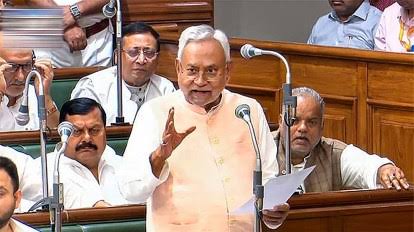In a significant political development, Janata Dal (United) chief Nitish Kumar has been sworn in as Bihar’s Chief Minister for the ninth time, marking a historic feat. This comes after a strategic political move where Nitish Kumar severed ties with the opposition alliance led by Lalu Prasad Yadav’s RJD and the Congress. The seasoned politician has now joined hands with the Bharatiya Janata Party (BJP) led National Democratic Alliance (NDA) to form a new government in the state.
A total of eight leaders, including three from the BJP (Samrat Choudhary, Vijay Kumar Sinha, and Prem Kumar), three from JD(U) (Vijay Kumar Choudhary, Bijendra Prasad Yadav, and Shrawon Kumar), and Hindustani Awam Morcha (Secular) President Santosh Kumar Suman, and independent MLA Sumit Kumar Singh, took oath as cabinet ministers in the new government led by Nitish Kumar.
The political maneuvering unfolded with Nitish Kumar tendering his resignation in the morning, citing dissatisfaction with the Mahagathbandhan and the opposition bloc INDIA. Subsequently, he staked a claim to form a new government with the BJP, a party he had distanced himself from less than 18 months ago.
At the state BJP office, party MLAs unanimously agreed to support JD(U), and leaders Samrat Choudhary and former Speaker Vijay Kumar Sinha were named as leader and deputy leader, respectively, of the legislature party. They accompanied Nitish Kumar to Raj Bhavan to formalize the claim.
The move marked a departure from the previous alliance with the opposition INDIA bloc, which included the RJD and Congress. Despite having the largest number of MLAs in the Bihar assembly, the RJD appeared reluctant to stake a claim, allowing Nitish Kumar to seize the opportunity for a political realignment.
The CPI(ML) Liberation, which had supported the Mahagathbandhan government from outside, strongly criticized Nitish Kumar, accusing him of betrayal. In a scathing Facebook post, the party’s general secretary Dipankar Bhattacharya alleged that Kumar, with the longest stint as CM, would be used by the RSS-BJP combine as a pawn.
Political strategist turned politician Prashant Kishor also weighed in, taking a swipe at Kumar while suggesting that the BJP might pay a “huge price” for supporting the JD(U) chief who had previously switched allegiances.
Nitish Kumar’s political journey has been marked by strategic alliances and realignments. He first became Bihar’s Chief Minister in 2000, followed by subsequent terms in 2005, 2010, and 2015. His political maneuvers include resignations, coalitions, and alliances, showcasing the fluidity of Bihar’s political landscape.
In the current 243-member Bihar Assembly, JD(U) has 44 MLAs, the BJP has 78, and Kumar also enjoys the support of one Independent member. The new alliance, which includes the Hindustani Awam Morcha, has the numerical strength to form a government.
Nitish Kumar’s return as Chief Minister sets the stage for a new chapter in Bihar’s political narrative, as the state navigates through the complexities of coalition politics. The dynamics of this alliance will be closely watched as it shapes the future trajectory of Bihar’s governance.

